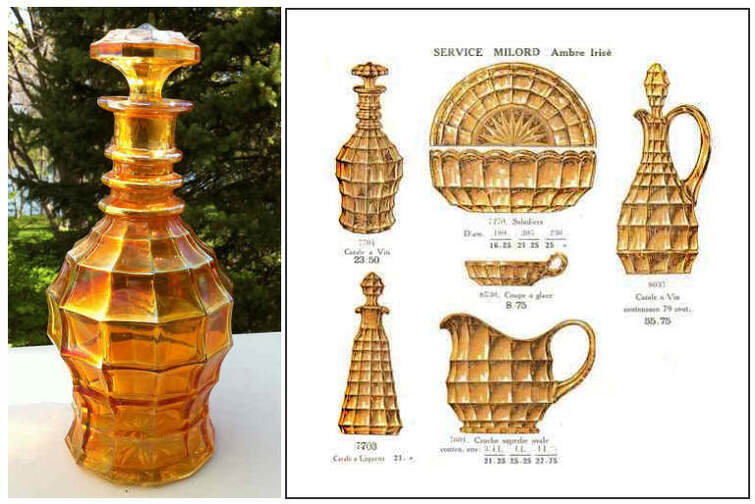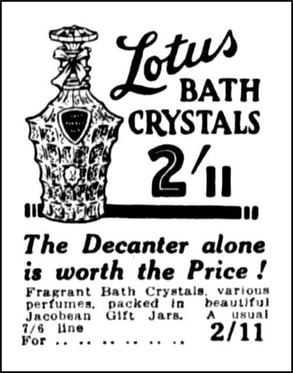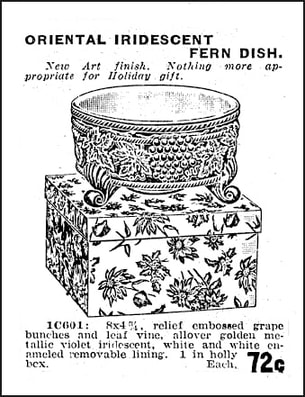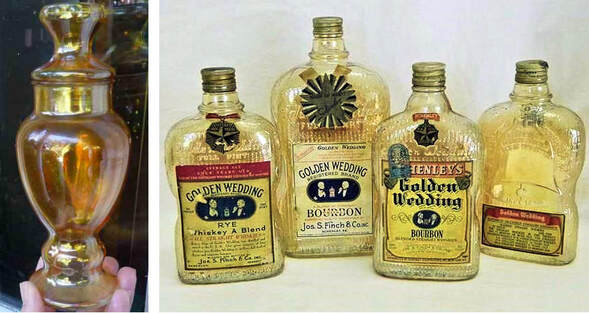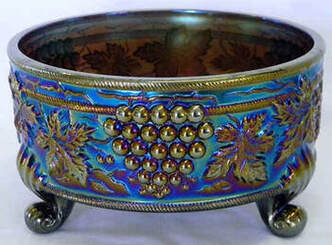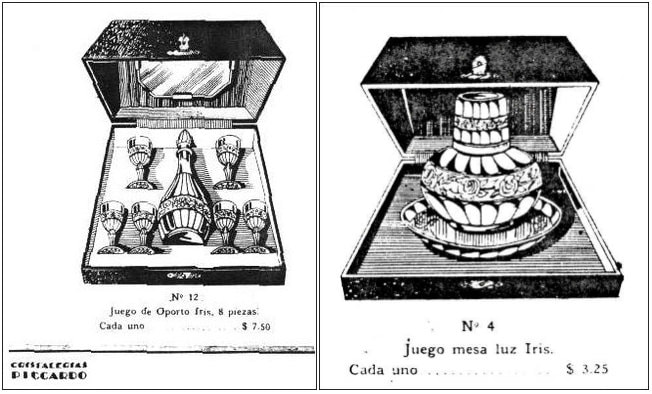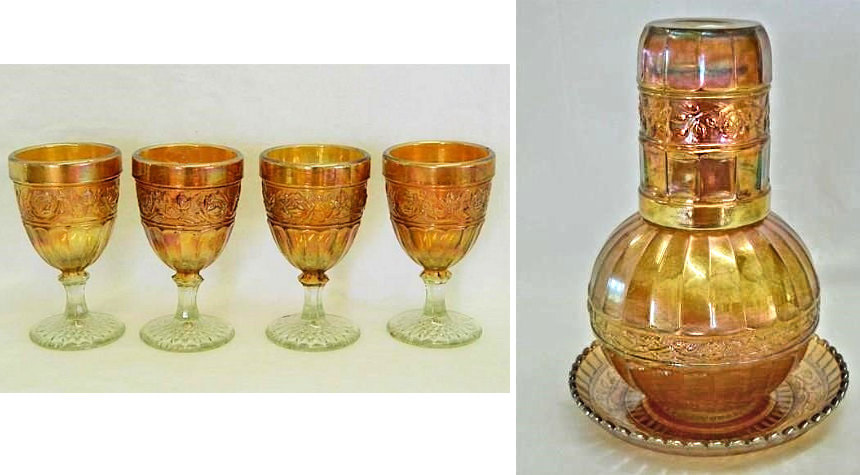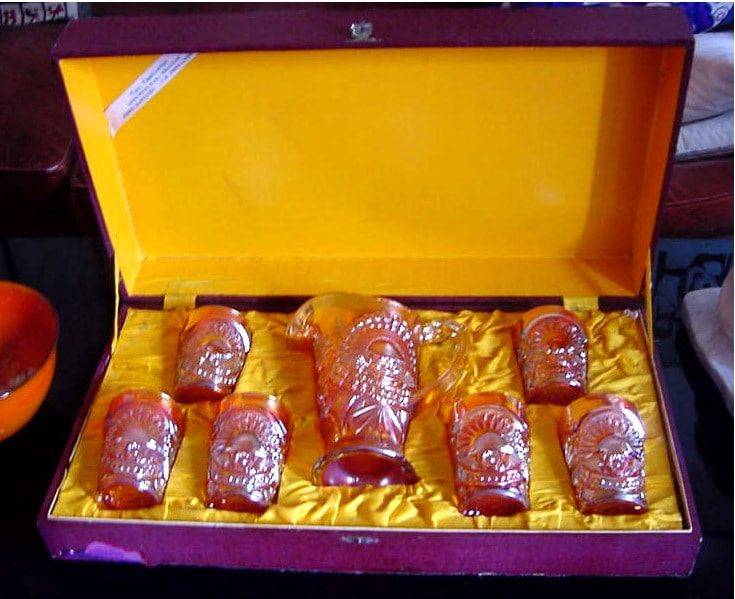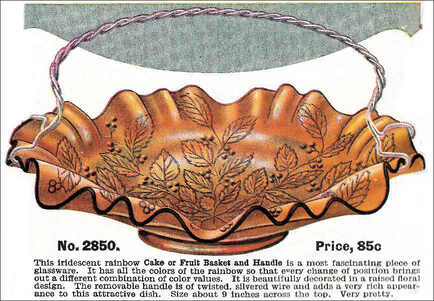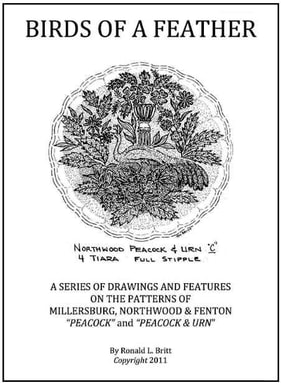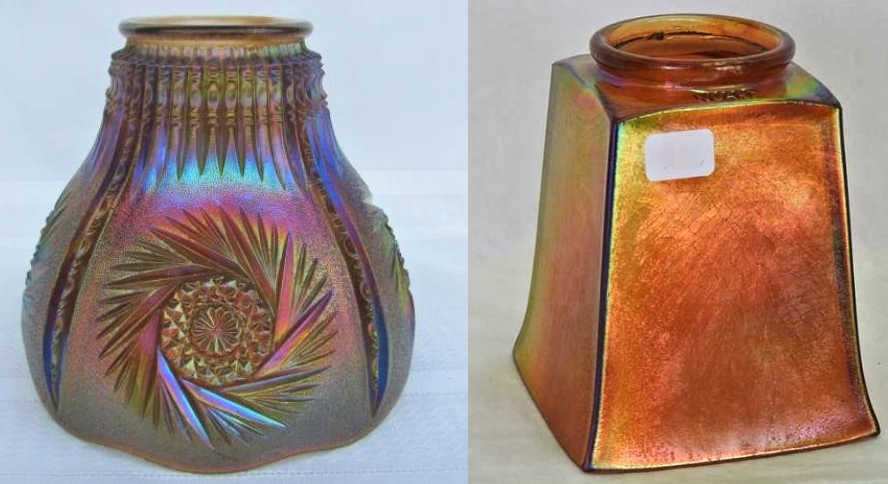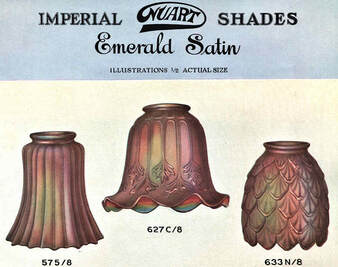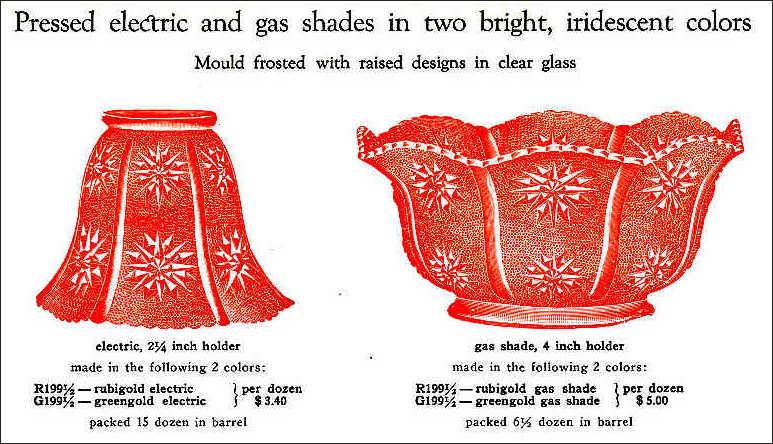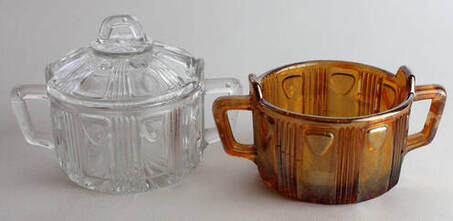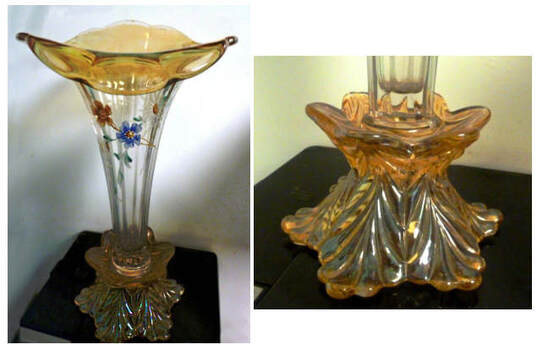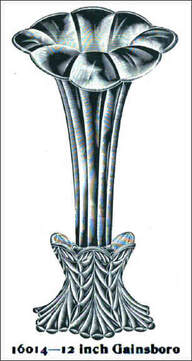NetworK ezine Issue 57. February 2020
Totally Devoted to Carnival Glass
Welcome to our February issue of NetworK, which (we are sure you will agree) is an absolute gift. Not only do we have an extensive article on Gift Wrapped Carnival, we also have a splendid gift for all our readers; "Birds of a Feather" - a truly wonderful educational resource to identify peacock patterns, thanks to Ronald L. Britt. And there’s more! We light up your life with our comprehensive Gallery feature on Imperial’s Lampshades – complete with some amazing catalogue illustrations. And we have a fascinating and unusual find from Finland, courtesy of researcher Roger Peltonen.
If all that isn’t enough, we also have an amazing “Stop the Press” feature. This show-stopping discovery unfolded on our Carnival Glass Network Facebook page in late January, thanks to Greg Dilian. It’s unmissable!
If all that isn’t enough, we also have an amazing “Stop the Press” feature. This show-stopping discovery unfolded on our Carnival Glass Network Facebook page in late January, thanks to Greg Dilian. It’s unmissable!
Gift Wrapped
This splendid decanter on the right featured in an ad for “Lotus Bath Crystals” in a Sydney newspaper, the Sydney Sun, in 1927 (image courtesy National Library of Australia). The sharp-eyed reader will spot right away that the decanter is Inwald’s magnificent Jacobean (albeit with a touch of artistic licence), daintily tied with a bow at the neck! The decanter is a large item, and would have held plenty of fragrant bath crystals.
This splendid decanter on the right featured in an ad for “Lotus Bath Crystals” in a Sydney newspaper, the Sydney Sun, in 1927 (image courtesy National Library of Australia). The sharp-eyed reader will spot right away that the decanter is Inwald’s magnificent Jacobean (albeit with a touch of artistic licence), daintily tied with a bow at the neck! The decanter is a large item, and would have held plenty of fragrant bath crystals.
|
And just look at the price reduction (in the pre-decimal Australian currency) - down from 7/6 (seven shillings and six pence) to 2/11 (two shillings and eleven pence). And for that, you even got a ribbon on it. Glassware used as packing containers is not such an unusual idea – certainly Carnival bottles, such as the Golden Wedding whiskey bottles, Inca Bottles and others, contained beverages. The iridised Jackson Brothers Jars, made in Knottingley, England, have been found containing bath salts or remnants of talcum powder. But this is the first time we have seen a splendid piece of glass from Inwald, being used as a container. |
Far left: Jacobean decanter, courtesy the late Michael O’Brien (left) and on the immediate leftt is an extract from the Markhbeinn catalogue featuring Inwald’s Carnival, c. 1928. Milord was the name in the catalogue for the pattern we know as Jacobean. Inwald actually called it "Lord", but the British marketing specialist, Clayton Mayers, promoted it under the name Jacobean. |
|
More gift containers.
This Jackson Brothers marigold container (shown on the immediate right) once held bath crystals or talcum powder. Examples are also known in pastel blue and lavender iridescence. On the far right are various marigold Golden Wedding whiskey bottles. Naturally, the contents are long gone! Courtesy Seeck Auctions. As well as being the actual gift container itself, Carnival was also offered in presentation gift boxes. |
|
Presentation boxes, with metal clasps, were a feature of some Argentinean Carnival items, particularly from Cristalerias Piccardo in Bueonos Aires. In their 1934 catalogue, Piccardo offered boxed sets comprising of several Carnival Glass items in the Band of Roses pattern, such as the splendid presentation box sets below.
|
Above on the left is a decanter set, and on the right a tumble-up with tray. Both sets are Band of Roses, made by Cristalerias Piccardo. Note that they are described as “Iris” – meaning iridescent.
|
Shown above are some examples of the wonderful Band of Roses pattern made by Piccardo. On the left is a set of four Band of Roses stemmed wine glasses – the word PICCARDO is moulded on the base of each glass - and on the right is a tumble up complete with undertray.
Both pictures courtesy Seeck Auctions. |
|
Staying with box sets, the one shown below, left, is a Rising Sun water set, shown courtesy Jorge Perri and the late Jorge Duhalde. The maker of this amazing set is not certain.
We have more about this water set here: Rising Sun Gift Set |
And finally, if it wasn’t available in a gift box or tied with ribbons, well, you could always “pretty-it-up” with a fancy handle!
The delightful gift basket shown above was offered in the Perry G Mason mail order catalogue in 1925. It comprises a marigold Fenton Holly bowl with a three-in-one crimped edge, and has a “removable” metal handle attached to the sides. The handle transforms the bowl into a “cake or fruit basket”, according to the ad’s description. |
|
Now - a Gift for You! Courtesy of Ronald L. Britt.
We are pleased to announce that we have been given the opportunity and privilege of hosting Ronald L. Britt’s excellent work, “Birds of a Feather” on our website. Ronald's work shows, through superb drawings and detailed features, how to tell the difference between Millersburg, Northwood and Fenton versions of “Peacock” and “Peacock & Urn”. His extensive and authoritative work is featured in high resolution, each drawing being shown in fine detail, perfect for studying these wonderful patterns. Our grateful thanks to Ronald – we know that everyone will enjoy his excellent work. "Birds of a Feather" is presented in superb detail over Six Sections. Be sure not to miss any of them. Click on the image on the right or here: Birds of a Feather. This takes you to Section One, which has links to all the other Sections. |
|
We shed the light ... on ... Imperial Lamp Shades.
In the early days of Classic Carnival production (around 1907 or thereabouts), candles, kerosene lamps and gaslights were the main ways to provide illumination in the home. It's no surprise that Carnival Glass makers exploited the market, and up until around 1910, wholesale ads for Carnival (and glass generally) showed candle sticks and oil / kerosene lamps of all shapes and sizes. But a change was afoot, and glassmakers had to react - quickly. It was the increasing availability of relatively affordable electric light bulbs ... and glassmakers saw a new opportunity for the production of glass shades for the new electric light fittings. Lampshades seem to be an under-explored area of Carnival Glass and they caught our attention when we saw a copy of Imperial's Catalog 104-F, "Pressed Glassware for Illumination", dated around 1918 (catalogue courtesy of Jon D. Bartell). We realised just how many Carnival Glass shades were made by Imperial! Mainly for electric fittings, but also larger shades, in matching patterns, for gas lighting. |
Above, left is a Buzz Saw shade in smoke (courtesy of Burns Auctions) and on the right is a dark marigold Four Sided shade (aka Imperial #601, aka Plain Square, courtesy of Seeck Auctions).
|
In a new four-page feature on our website, we explore Imperial's Carnival "Glassware for Illumination".
There are several amazing catalogue pages (courtesy and copyright Jon D. Bartell) of iridised "NUART" and "Bright Iridescent Shades" made by Imperial.
Here are two small extracts.
And to help you identify the shades (which is not always easy!), we have put together a Gallery of Imperial Carnival Glass Lampshades (thanks to Tom & Debra Burns, and Jim & Jan Seeck for permission to use their photos). Currently, there are about 50 shades in the Gallery.
To see this featured article, go here: "Glassware for Illumination"
To go directly to the Imperial Lampshade Gallery, go here: Imperial Shades Gallery
To see this featured article, go here: "Glassware for Illumination"
To go directly to the Imperial Lampshade Gallery, go here: Imperial Shades Gallery
|
Onni
The fascinating marigold butter dish shown here, was recently discovered by glass researcher, Roger Peltonen, in the Helsinki area of Finland. Although the covered butter was already known in clear glass, this marigold Carnival discovery was a *first*. Roger explained to us that Onni is the original maker’s name (OMN) for this fascinating piece, and it has a delightful meaning … happiness or luck. Using Roger’s photos and wonderful research information, we have assembled a Collectors Facts feature on this discovery. The full story with excellent photos and information about the subsequent makers of this piece, is all on our website here: Collectors Facts - Onni. |
Above: Onni, in clear (crystal) and in marigold.
Photo courtesy Roger and Tuula Peltonen. |
Stop The Press
As we were putting the finishing touches to this issue of Network, a fascinating post appeared in our Carnival Glass Network Facebook Group. It was this vase (below, left). It is iridised at its mouth and on its magnificent base, and it has a delicate enamelled floral decoration on the central section.
The elaborate base caught everyone’s eye – but who made it and when?
As we were putting the finishing touches to this issue of Network, a fascinating post appeared in our Carnival Glass Network Facebook Group. It was this vase (below, left). It is iridised at its mouth and on its magnificent base, and it has a delicate enamelled floral decoration on the central section.
The elaborate base caught everyone’s eye – but who made it and when?
The answer was provided just one hour and forty minutes after Greg posted his mystery vase into our Group.
Terri Frauzel explained that she believed it was a U.S. Glass item. An hour and a half later, she showed us the U.S. Glass ad that illustrated the exact vase - see above, right. We were blown away! The date of the ad was 1896. Greg’s vase is iridised (albeit not all-over) and moulded. It’s Carnival Glass!
Early Carnival Glass that almost certainly was made around the same time as Edward Moore’s early Carnival in England.
And by studying the 1896 ad, we can also add the U.S.Glass original pattern name – their #16014 12 inch Gainsboro. The full story, the entire 1896 ad plus more photos that will surprise you, can be seen in our Collector Facts page on this astonishing vase. Sincere thanks to Greg Dilian and Terri Frauzel.
Here is the link: Collectors Facts - Gainsboro
Terri Frauzel explained that she believed it was a U.S. Glass item. An hour and a half later, she showed us the U.S. Glass ad that illustrated the exact vase - see above, right. We were blown away! The date of the ad was 1896. Greg’s vase is iridised (albeit not all-over) and moulded. It’s Carnival Glass!
Early Carnival Glass that almost certainly was made around the same time as Edward Moore’s early Carnival in England.
And by studying the 1896 ad, we can also add the U.S.Glass original pattern name – their #16014 12 inch Gainsboro. The full story, the entire 1896 ad plus more photos that will surprise you, can be seen in our Collector Facts page on this astonishing vase. Sincere thanks to Greg Dilian and Terri Frauzel.
Here is the link: Collectors Facts - Gainsboro
Privacy and the use of your information: we only use your name and email address to send you your FREE Carnival Glass NetworK ezine. We will not share your name or email address with anyone else, or use it for any other purpose. You can change your mind about receiving your NetworK ezine at any time by clicking the unsubscribe link at the foot of every issue, or by emailing us at [email protected]
Join us on Facebook
We invite you and your friends to join us all on NetworK's fast growing and very active Facebook Group (link is below), and if you have missed any of the previous issues of NetworK and NetworK Specials, they are all here: Back Issues.
We invite you and your friends to join us all on NetworK's fast growing and very active Facebook Group (link is below), and if you have missed any of the previous issues of NetworK and NetworK Specials, they are all here: Back Issues.

